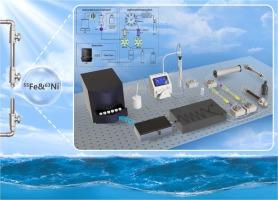Automated analysis of effluents from nuclear facilities for 55Fe and 63Ni
IF 11.3
1区 环境科学与生态学
Q1 ENGINEERING, ENVIRONMENTAL
引用次数: 0
Abstract
Anthropogenic 55Fe and 63Ni are key radionuclides in liquid effluents from nuclear facilities and are of great concern for environmental radiological impact assessment. While various analytical methods have been reported, they rely on manual operations, making them time-consuming, labor-intensive, and unsuitable for on-line or in-situ monitoring. This study presents a fully automated sequential-injection system that integrates precipitation pretreatment, dual-column chromatographic separation, and liquid scintillation detection, enabling rapid and in-situ analysis of 55Fe and 63Ni in nuclear effluents. The system incorporates programmable control algorithms to optimize parameters such as carrier volume, flow rate, and eluent concentration. It achieves high chemical yields—96% ± 3% for 55Fe and 92% ± 4% for 63Ni—with low analytical uncertainties (below 6% and 7%, 2σ). The system effectively eliminates matrix interferences, maintains robust performance under varied flow conditions, and enables fully automated processing of 1 L samples within 50 minutes. Compared to conventional manual methods, it significantly improves efficiency and reduces radiation exposure. This work demonstrates a promising platform for real-time radiological monitoring of effluents from nuclear facilities and is adaptable for other radionuclide analysis scenarios.

核设施流出物中55Fe和63Ni的自动分析
人为55Fe和63Ni是核设施流出液中的关键放射性核素,是环境辐射影响评价的重点。虽然已经报道了各种分析方法,但它们都依赖于人工操作,这使得它们既耗时又费力,而且不适合在线或现场监测。本研究提出了一种集沉淀预处理、双柱色谱分离和液体闪烁检测于一体的全自动序贯进样系统,可实现核废水中55Fe和63Ni的快速原位分析。该系统结合了可编程控制算法,以优化参数,如载体体积,流速和洗脱液浓度。化学收率高,55Fe为96% ± 3%,63ni为92% ± 4%,分析不确定度低(低于6%和7%,2σ)。该系统有效地消除了基质干扰,在不同的流量条件下保持稳定的性能,并在50分钟内实现了1升样品的全自动处理。与传统的手工方法相比,它大大提高了效率,减少了辐射暴露。这项工作证明了对核设施流出物进行实时放射性监测的一个有前途的平台,并适用于其他放射性核素分析方案。
本文章由计算机程序翻译,如有差异,请以英文原文为准。
求助全文
约1分钟内获得全文
求助全文
来源期刊

Journal of Hazardous Materials
工程技术-工程:环境
CiteScore
25.40
自引率
5.90%
发文量
3059
审稿时长
58 days
期刊介绍:
The Journal of Hazardous Materials serves as a global platform for promoting cutting-edge research in the field of Environmental Science and Engineering. Our publication features a wide range of articles, including full-length research papers, review articles, and perspectives, with the aim of enhancing our understanding of the dangers and risks associated with various materials concerning public health and the environment. It is important to note that the term "environmental contaminants" refers specifically to substances that pose hazardous effects through contamination, while excluding those that do not have such impacts on the environment or human health. Moreover, we emphasize the distinction between wastes and hazardous materials in order to provide further clarity on the scope of the journal. We have a keen interest in exploring specific compounds and microbial agents that have adverse effects on the environment.
 求助内容:
求助内容: 应助结果提醒方式:
应助结果提醒方式:


